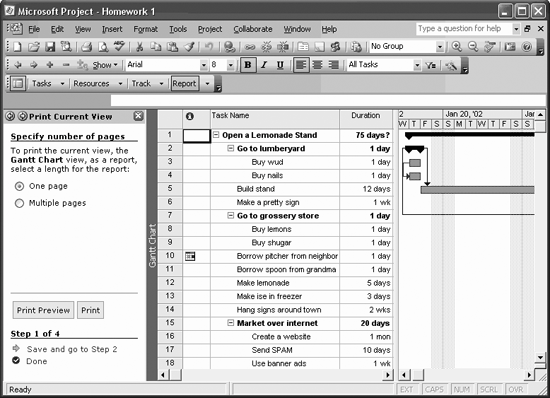Lesson 1.3. What's New in Project 2003? Figure 1-3. The Print Current View as a Report option 
Before we start talking about new features of recent and past versions of the program, it helps if you actually understand what Project 2003 really isa database. In its simplest form, a database is a collection of information that is organized into a list. Here is what a good database does: Stores Information: A database stores lists of information that are related to a particular subject or purpose. A database stores personal information, such as a list of Aunt Mildred's cookie recipes, or business information, such as a list of hundreds of thousands of resources. A database also makes it easy to add, update, organize, and delete information. Finds Information: You can easily and instantly locate information stored in a database. For example, you can find all the recipes in your cookbook with the ingredient "rice" in them or all your contractors located in the 58251 ZIP Code. Analyzes Information: You can perform calculations on information in a database. For example, you could calculate what percent of your total equipment comes from the state of Texas. You can also present information in a professional-looking printed report. Manages Information: Databases make it easy to work with and manage huge amounts of information. For example, you can change the due date from 5/1/06 to 5/20/06 for hundreds of tasks with just a few keystrokes. Shares Information: Most database programs (including Microsoft Project 2003) allow more than one user to view and work with the same information at once. Such databases are called multiuser databases.
Project does all of these things, with the added bonus that it actually calculates information for scheduling the project. Table 1-3 lists some of the major additions to Project 2003, as well as new additions for users upgrading from Project 2000 or earlier. Table 1-3. What's New in Project 2003?Feature | Definition |
|---|
New in 2003 | Print Current View as a Report | Print a view the way you want to in Project 2003, as shown in Figure 1-3. Click the Report button list arrow on the Project Guide toolbar to summon a wizard that will help guide you through the steps of printing a view as a report. | Copy Picture to Office Wizard | This feature allows you to display project data as a static picture in other applications, such as PowerPoint. This feature is found in the Analysis toolbar. | New in 2002 | Project Guide | This wizard-like feature appears in the left pane to help you build a new project, manage tasks and resources, specify and change working time, track your project, and report project information. | Smart Tags | These context-sensitive tags offer advice for alternative actions as you delete task or resource names and change resource assignments; start and finish dates; and work, units, or durations. | Task panes | The task pane appears on the left side of the screen and lets you quickly perform searches, open or start a new document, view the contents of the clipboard, or even access language translation and template services. | Improved views | Functionality has been added to the Network Diagram view and usage views (for example, including totals in a view). You can also display up to three timescales in some views. | Integrated with other programs | Project is XML-compatible so you can import, export, and save files in XML format. Easily import data from Microsoft Excel and export data back to Excel, and import/export other supported file types. Project managers can use the Excel Task List template to start their task lists. They can then import this Excel file into Microsoft Project smoothly, without having to map any fields. Easily import a task list from Microsoft Outlook into Microsoft Project. | Improved collaboration features | New features, such as the new Collaboration menu, make it easier to access, manage, and use collaborative projects. |
Don't worry if you don't understand all of these features; Table 1-3 is a lot of tech-speak! What's important is that you learn how to use the program. That said, let's get going... |
